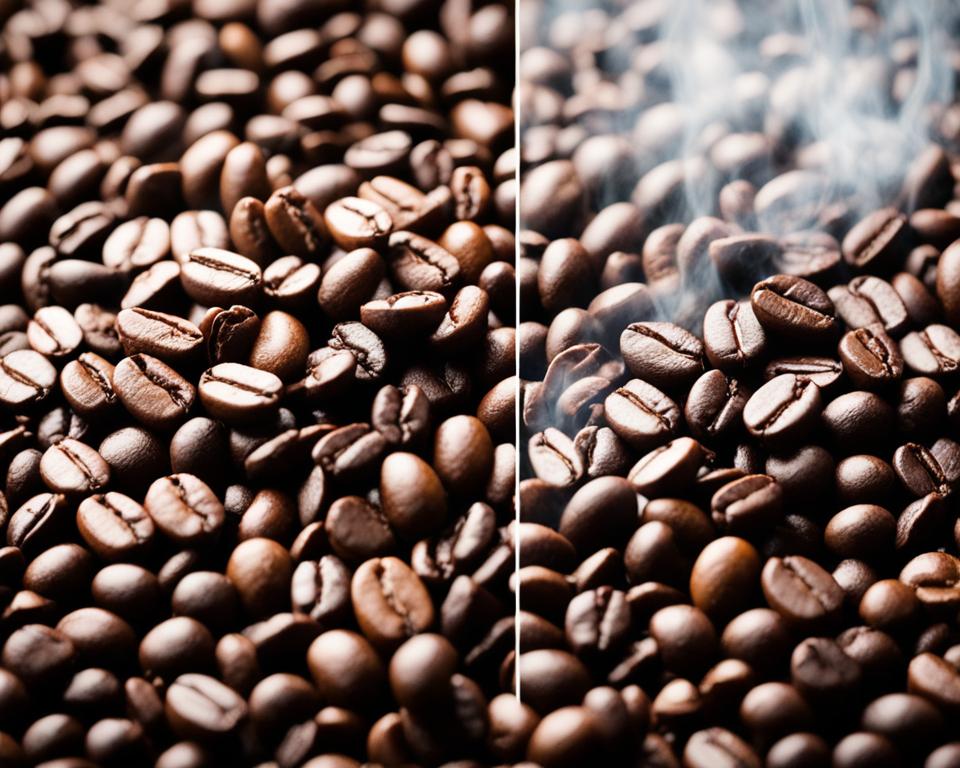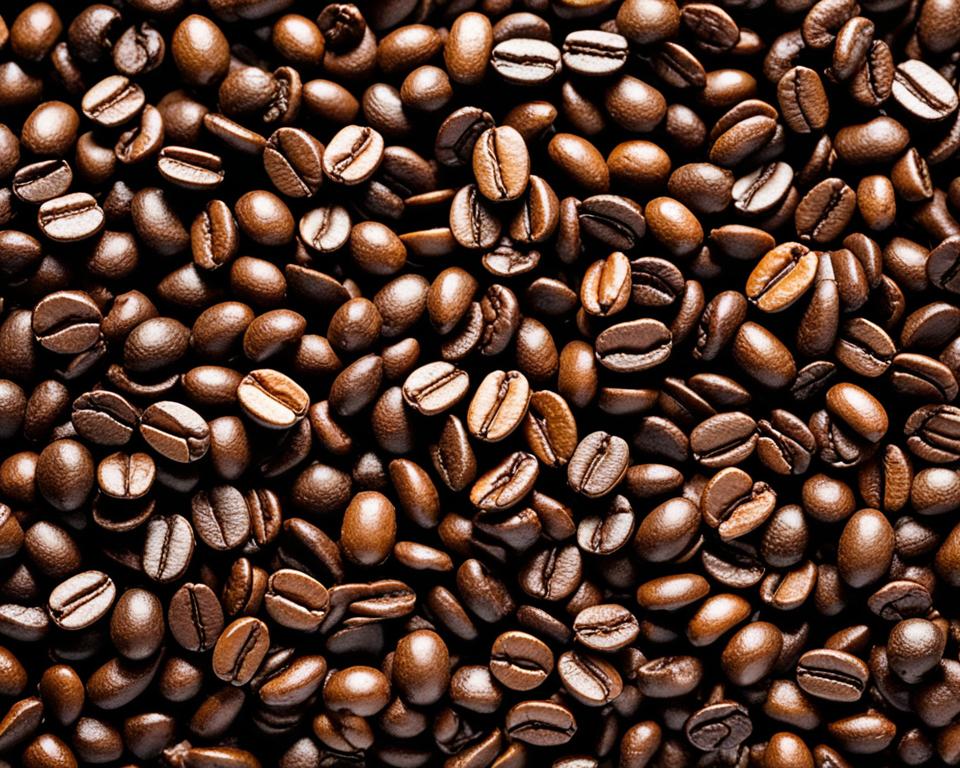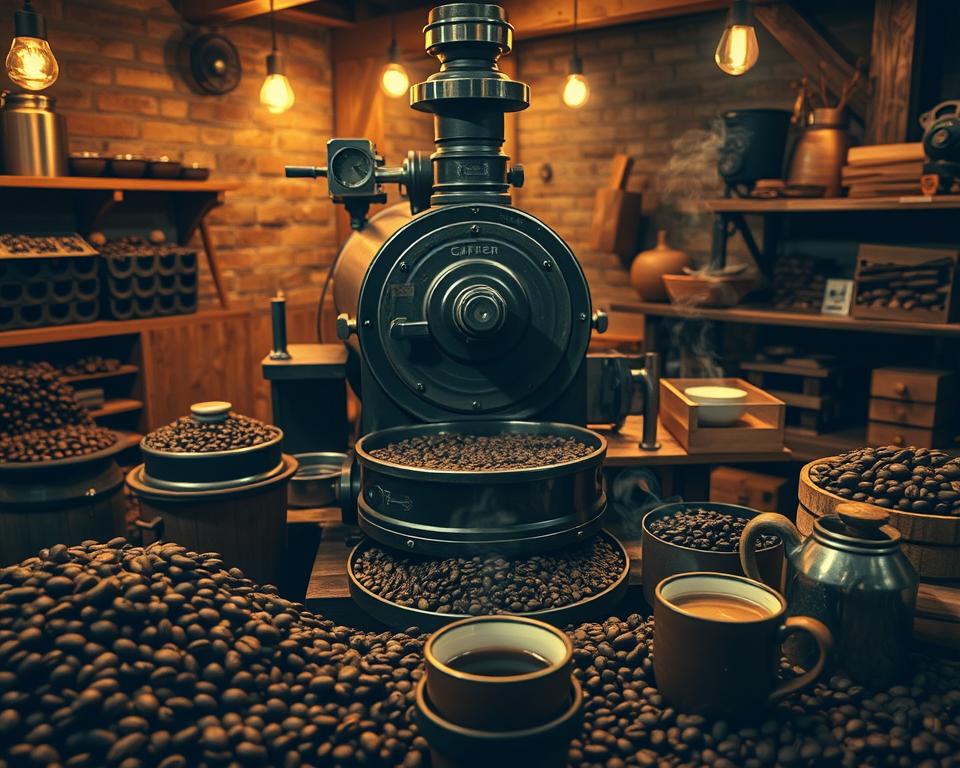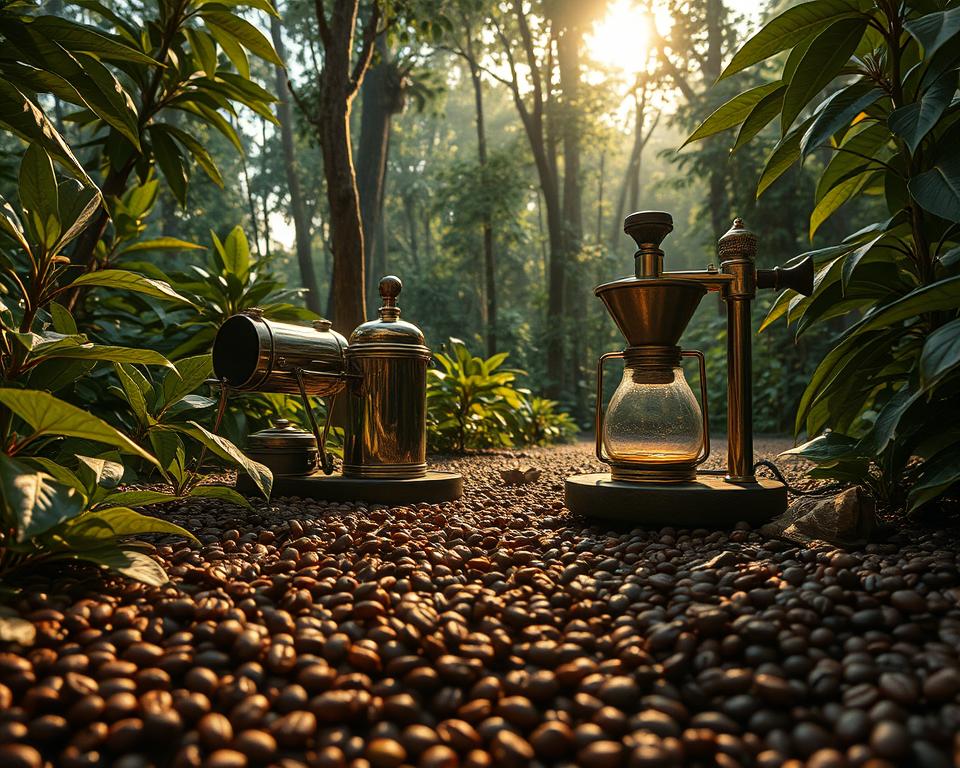Only 5% of the world’s coffee uses dry processing. This fact shows how unique each coffee can be. For lovers of coffee, knowing the difference between wet and dry processes is important. Uncover how each method influences your morning cup by exploring the unique flavours and nuances of wet vs. dry processed coffee.
It helps understand the varied flavours each method produces.
Arabica beans like wet processing for a bright and acidic taste. Robusta beans lean towards dry processing, which offers a sweeter, fuller taste.
Each method brings out unique flavours and characteristics of the bean.
Understanding this can help you choose beans that match your taste. For both serious coffee lovers and occasional drinkers, this knowledge can enhance the coffee experience. It brings a new level of enjoyment with every cup.
Key Takeaways
- Only about 5% of the world’s coffee undergoes dry processing.
- Wet processing often enhances the brightness and acidity of Arabica beans.
- Dry processing typically results in a sweeter and fuller-bodied flavour, common in Robusta beans.
- Understanding coffee processing helps you select beans that match your flavour preferences.
- Both methods offer unique characteristics, enriching your coffee-drinking experience.
Introduction to Coffee Processing Methods
The coffee world is huge and varied, largely due to the many coffee processing methods used. Understanding these methods gives us insight into how coffee brewing techniques and the taste of our coffee are affected.
There are mainly two coffee processing methods: wet and dry. They both change raw coffee beans into a form that can be roasted. But how they do this, their history, and the flavour they end up with are very different.
One of the oldest ways is the dry method, often called the “natural” method. Here, the whole cherry is dried after picking. It’s used a lot in sunny places with little water, like Ethiopia and Yemen.
Wet processing, or “washed” processing, on the other hand, takes the pulp off the cherries before drying the beans. This needs more water and better places to work, which is why you see it more in areas like Colombia and Central America. This method makes coffee that is cleaner, has a brighter taste, and has stronger acidity than dry-processed coffee.
Lately, there’s been more interest in new ways to process coffee. This includes techniques like honey processing and semi-washed processing.
These new ways mix parts of both the wet and dry methods to create special flavour profiles.
Here’s a simple look at the main differences between wet and dry processing:
| Aspect | Wet Processing | Dry Processing |
|---|---|---|
| Water Usage | High | Low |
| Flavor Profile | Clean, Bright, and acidic | Sweet, Fruity, and full-bodied |
| Regions | Central America, Colombia | Ethiopia, Yemen |
Learning about the basic coffee processing methods is a fun way to better understand how coffee gets from beans to cup. Once you dig deeper, you’ll see how these methods connect to what’s happening in the coffee industry.
You might also notice how they affect the coffee-brewing techniques you enjoy at home.
How Wet Processed Coffee is Made
Wet-processed coffee is a popular method among specialty coffee producers. It’s favoured for enhancing the coffee’s flavour profile. We’ll look at the step-by-step process and how it affects coffee production and taste.
Step-by-Step Process
Harvesters pick ripe coffee cherries, often Arabica beans, to start the process. Next, they go into a pulping machine to remove the outer pulp and skin.
This step is key to preparing the beans for fermentation.
Then, the beans move to fermentation tanks filled with water for 12 to 48 hours. This water breaks down the mucilage around the beans, enhancing their natural sugars and flavour.
After fermentation, the beans are washed to remove any residue.
After washing, the beans dry to lower their moisture content. This can be done on patios, by mechanical dryers, or on raised beds. It ensures the beans have a consistent texture, which is crucial for quality coffee.
Finally, the beans are hulled, removing any remaining parchment, and are ready for roasting.
The Impact on Flavour
Wet-processed coffee is famous for its bright acidity and clean, crisp flavor. This process often brings out lively fruit and floral notes, enhancing the taste.
The carefully controlled fermentation and washing steps highlight these flavours, making wet-processed coffee a favourite in the specialty sector.
Common Regions Using Wet Processing
Wet processing is common in many coffee-growing areas, especially in Latin America. Countries like Colombia, Guatemala, and Costa Rica are known for using this method.
Good climate conditions and access to water help with efficient wet processing.
These areas choose wet processing to make high-quality Arabica beans with unique flavors. The even climate and plenty of water help with the delicate processing.
This approach highlights the coffee’s special taste, making it known worldwide.
| Region | Method | Key Characteristics |
|---|---|---|
| Colombia | Wet Processing | Bright acidity, citrus and floral notes |
| Guatemala | Wet Processing | Rich body, complex fruit flavors |
| Costa Rica | Wet Processing | Clean, balanced, fruity undertones |
How Dry Processed Coffee is Made
Exploring dry-processed coffee reveals a historic brewing method. This method unveils a taste that modern techniques do not replicate. Dry processing has its own unique story.
Step-by-Step Process
The process begins with selecting the finest coffee beans. Then, we lay these beans out to dry in the sun. This marks the start of creating the distinct flavour of dry-processed coffee.
We place the beans on elevated surfaces for drying.
We regularly turn them to ensure even drying.
It takes some time, often weeks, for the beans to dry completely.
Once dried, we husk the beans to remove the fruit and parchment layers.
This method demands patience and precision. Unlike the wet method, it relies on nature’s touch for flavour development.
The Impact on Flavour
Dry-processed coffee boasts a unique taste. This drying method allows the beans to absorb sugar from the fruit. As a result, we often enjoy a sweet, rich cup of coffee. Robusta coffee, processed this way, highlights deep, earthy, and nutty flavours.
Common Regions Using Dry Processing
Dry processing is preferred in regions with limited water, such as parts of Africa and Brazil. Ethiopia, the birthplace of coffee, extensively employs this method.
It yields coveted beans with fruity and wine-like notes.
In Brazil, dry processing unveils sweet, nutty, and full-bodied beans. The local climate and terrain significantly influence the coffee’s flavour.
| Region | Processing Type | Key Characteristics |
|---|---|---|
| Ethiopia | Dry Processing | Fruity, wine-like flavors |
| Brazil | Dry Processing | Sweet, nutty, and full-bodied |
Learning about these methods and where they’re used deepens our understanding of coffee. It makes every sip more enjoyable and meaningful.
Comparing wet vs. dry processed coffee
The way coffee is processed, whether it’s wet or dry, really changes its taste. Each method brings out different flavours, affects how rich or light the coffee feels, and affects its overall texture.
Today, let’s look at how these methods differ and what each one offers.
Wet vs. Dry Processed Coffee: Flavour Profiles
Wet-processed coffee is bright and tangy, with hints of fruit and flowers. Known as washed coffee, this method keeps the natural tastes of the beans alive.
The result is a clean and steady flavor. On the flip side, dry processed coffee, or natural coffee, has a heavy, sweet taste. It’s richer, with notes of berries and even chocolate.
Wet vs. Dry Processed Coffee: Texture and body
The feel and weight of the coffee are also quite different based on processing. Wet-processed coffee is light and smooth, favoured by those who like it gentle.
Dry-processed coffee, however, is heavier with a syrupy feel, perfect for coffee lovers who prefer a strong, bold sip.
Wet vs. Dry Processed Coffee: Pros and Cons of Each Method
Each method has its good and bad sides. Wet processing is loved for its clear taste and reliable outcome, but it uses a lot of water and might not be great for the environment.
Dry processing can give a coffee more complex and bold flavours, yet it relies on perfect weather and needs a lot of effort for drying.
| Aspect | Wet Processed Coffee | Dry-processed coffee |
|---|---|---|
| Flavor Profiles | Bright, acidic, fruity & floral | Sweet, full-bodied, berry & chocolate |
| Texture and Body | Lighter body, smooth | Heavier body, syrupy |
| Pros | Clarity and consistency | Complex, bold flavors |
| Cons | Water-intensive, less eco-friendly | Weather-dependent, labor-intensive |
Specialty Coffee and Processing Techniques
The coffee industry is changing fast, and specialty coffee is at the heart of this movement. Specialty coffee stands out for its top quality and unique tastes.
It uses special methods that make each cup different from the next.
There’s a new trend in coffee making that combines old and new ways. These mixes bring out exciting and rich flavours.
One example is a method called anaerobic fermentation. It uses special conditions to change the beans, creating an unusual and tasty coffee.
People want to know where their coffee comes from. They care about how it’s made and whether it helps the planet. Coffeemakers are working harder to meet these demands.
They are going green, from planting to making the final product. This care not only gives us better coffee but also helps farmers and their families.
Now, let’s look at how different ways of processing coffee change its taste:
| Processing Method | Flavor Profile | Regions |
|---|---|---|
| Wet Processing | Bright, Fruity, and clean | Latin America, East Africa |
| Dry Processing | Sweet, Full-bodied, and complex | Brazil, Ethiopia |
| Hybrid Processing | Varied, Multi-dimensional | Boutique Farms Worldwide |
Specialty coffee is not just any coffee; it’s something to savour and enjoy. With new trends, we can expect more amazing ways to enjoy our daily coffee.
The Role of Coffee Roasting in Flavor
Coffee roasting changes the taste of beans from plain to rich and flavorful. Each method can make the beans’ natural qualities shine or hide them.
We’ll look at how these techniques change your coffee’s flavour and smell. We’ll also share tips for those eager to roast at home.

How Roasting Affects Wet and Dry Processed Coffee
The roasting method affects the coffee you drink, especially for wet or dry processed beans. Wet-processed beans often taste cleaner and brighter.
Roasting these beans brings out their acidity and creates a balanced cup.
Dry-processed beans, on the other hand, offer more deep, full-bodied flavours with added sweetness. This is because they contain more complex sugars that develop during roasting.
Tips for Roasting at Home
If you want to try roasting at home, here are some tips:
- Choose high-quality green beans. The type, like Arabica or Robusta, changes the flavour.
- Experiment with different ways to brew the coffee after roasting. It shows off the variety of flavours you can create.
- Consider the roasting time and temperature carefully. Light roasts highlight the bean’s original taste, while dark roasts add a bold flavour.
Roasting coffee at home requires attention to detail. Keep track of your approach and adjust to meet your taste as you go.
How Does Roasting Influence the Taste of Wet vs. Dry Processed Coffee?
Roasting significantly alters the flavor profiles of coffee, making the impact of roasting on coffee essential for connoisseurs. Wet processed coffee often showcases brighter acidity and fruity notes, while dry processed coffee reveals a deeper, more earthy flavor. The roasting technique enhances these characteristics, creating a unique tasting experience for each type.
Conclusion
In our journey through the world of coffee, we’ve seen how wet and dry methods matter. Each way gives coffee its own unique taste, making it appeal to different people. The wet method makes coffee that’s lively with a clear taste, while the dry method makes fuller, sweeter coffees that tell where they’re from.
This article has shown the rich history and changes in coffee-making. By looking at wet and dry ways, we see their impact on what we taste and feel. This contrast adds a layer of enjoyment to your morning cup for anyone who loves coffee.
The future of coffee is exciting, with a strong focus on being eco-friendly and coming up with new tastes. People want to know where their coffee comes from and enjoy what makes it special. Exploring these areas more can deepen your love for coffee, from the field to your cup.
FAQ
What is the difference between wet and dry-processed coffee?
Wet-processed coffee removes the fruit from the beans before drying. It creates a cleaner, brighter flavor. This coffee also has higher acidity. Dry processing, on the other hand, involves leaving the fruit on the beans, thereby imparting a sweeter and full-bodied taste with fruity notes to the coffee.
How does the choice of processing method affect the flavour of coffee?
the way coffee processing impacts its taste. Wet processing makes coffee taste cleaner and more acidic. Dry processing makes it sweeter and fuller. This taste comes from how the beans and fruit interact during processing.
Which regions primarily use wet-processing methods?
In Latin America, countries like Colombia and Costa Rica use wet processing. Their climate is suitable for the needed washing and fermenting. This region is known for its wet-processed coffee.
Who predominantly uses dry processing?
Dry processing is common in sunny, stable places. For example, it’s popular in Ethiopia and Brazil. These areas choose dry processing for its simplicity and lesser need for resources.
What are the pros and cons of wet vs. dry processed coffee?
Wet processing makes coffee taste cleaner and brighter. However, it uses a lot of water and needs complex infrastructure. Dry processing gives coffee a sweeter, fuller taste. It’s simpler and more eco-friendly. But it might taste different because of outside elements during drying.
How does coffee roasting interact with wet and dry processed beans?
Roasting affects the taste of coffee. Light roasts are good for wet processed beans’ bright flavors. Dry-processed beans do well with various roasts. This brings out their sweetness and fruity notes.
Are there any specific coffee brewing techniques that pair well with wet or dry-processed coffee?
Choose light to medium roasts for wet processed beans to maintain acidity and brightness. For dry-processed beans, opt for medium- to dark roasts for a sweeter, fuller flavor. A keen home roaster with attention to detail can craft exceptional coffee.
What are the trends in the coffee industry regarding processing methods?
The coffee world is focusing on being sustainable and knowing where coffee comes from. Hybrid methods are gaining interest. They offer unique flavours while being eco-friendly. People also want specialty coffee. This is coffee that’s carefully processed, and the farm it’s from is well documented.
How can I roast coffee at home to get the best out of wet or dry processed beans?
Opt for light to medium roasts for wet processed beans to retain their natural acidity and brightness. For dry processed beans, go for medium to dark roasts to enhance their sweet, full taste. Skillful home roasting ensures great coffee.




